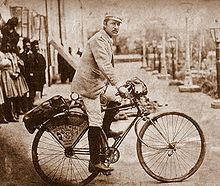Frank G. Lenz
The German-American Frank G. Lenz (born February 15, 1867 in Philadelphia , Pennsylvania , † May 1894 in Turkey ) tried from 1892 to 1894 with his 28 kilogram bicycle to be the first cyclist to circle the earth in an east-west direction. Because of his athletic performance, his journeys through little-known areas, and because of the circumstances of his death, he received greater media coverage for years.
prehistory
As early as 1891, Lenz caused a sensation with a bicycle ride from Pittsburg to New Orleans. Sponsored by Outing magazine and the Overman Bicycle Company , he started his circumnavigation of the world on June 4, 1892. M. Reymond wrote in the book Illustrierte Lander und Völkerkunde : “25 years old and of a small, compact, extremely sturdy build, Lenz possessed extraordinary endurance and was able to cover 100 English miles in one day even in hilly terrain and on sandy roads, without feeling particularly tired. "
Itinerary
In contrast to his predecessors, who had crossed America in a west-east direction due to the prevailing westerly winds, Lenz started in New York and crossed America in a westerly direction, not shying away from a detour to Canada. In San Francisco he embarked for Yokohama .
He was the first ever cyclist in northern China, about which little was known in the western world at the time, and the New York Times later wrote of his trip through that area: “His experiences in that country were most remarkable, and his achievements on that trip in that territory alone would well crown a man's life. Probably no Caucasians, except missionaries, ever traveled over that territory in Northern China. "
He cycled via Shanghai and Burma to India and on to Persia . The last message from him comes from May 2, 1894, when he left Tabriz for Constantinople .
Death in Turkey
Lenz was probably killed by robbers a few days later in the Erzurum area . The search for him turned out to be very difficult due to the isolation of Kurdistan , the riots against Armenians and the reluctance of the Ottoman authorities; Reliable news of his death did not arrive until June 1895. Under pressure from the US, Lenz's murderers were brought to justice, but they were only convicted of manslaughter and not - as the evidence suggested - murder.
The authorities then allowed the perpetrators to escape from prison. The United States therefore forced the Turkish government to pay compensation of US $ 7,500 to Lenz's mother. Decades later, this practice served as a model when governments were made jointly responsible for those crimes because of the failure of their authorities to prosecute crimes against foreigners.
Lenz's travel reports were published - each with a few months' delay - in the American sports magazine Outing under the title Lenz's World Tour Awheel . In their day, Lenz and other bicycle world travelers used such travel reports to familiarize their Anglo-American readership with distant parts of the world.
literature
- David Herlihy : The Lost Cyclist: The Untold Story of Frank Lenz's Ill-fated Around-the-world Journey . Mainstream Publishing Co. 2010
Web links
- Duncan R. Jamieson, Ph.D .: Bicycling and Violence (PDF file; 145 kB)
- Duncan R. Jamieson: A Sporting Tragedy: The Murder of Bicyclist Frank Lenz (PDF file; 122 kB)
- Travel reports from Lenz on the LA84 Foundation website
Individual evidence
- ^ New York Times , June 5, 1892
- ↑ Illustrated country and ethnology . Deutsche Volksbibliothek A.-G., Berlin approx. 1900
- ^ New York Times, March 1, 1895
- ↑ New York Times , November 21, 1894, December 26, 1894, January 7, 1895, March 1, 1895, April 10, 1895, April 16, 1895, April 23, 1895, May 3, 1895, May 21, 1895, June 13, 1895, June 21, 1895, June 22, 1895, June 26, 1895, August 3, 1895, September 30, 1895, March 28, 1897
- ↑ New York Times , November 1, 1895, November 8, 1895, November 10, 1895, December 12, 1895, December 20, 1895, October 16, 1896, April 8, 1897, April 27, 1897, June 13, 1897, October 5, 1897, December 29, 1897
- ^ New York Times , January 6, 1900, January 13, 1900, June 11, 1901, January 8, 1902
- ↑ United States Department of State: Papers relating to the foreign relations of the United States, with the annual message of the president transmitted to Congress December 3 , 1900 (1900), pp. 906-8 (Turkey)
- ↑ United States Department of State: Papers relating to the foreign relations of the United States, with the annual message of the president transmitted to Congress December 6 , 1904 (1904), p. 363 (Honduras)
- ↑ United States Department of State: Foreign relations of the United States diplomatic papers , 1937. The American Republics . Volume V (1937), p. 712 (Mexico)
| personal data | |
|---|---|
| SURNAME | Lenz, Frank G. |
| BRIEF DESCRIPTION | American cyclist who tried to cycle the world (1892-1894) |
| DATE OF BIRTH | February 15, 1867 |
| PLACE OF BIRTH | Philadelphia, Pennsylvania |
| DATE OF DEATH | May 1894 |
| Place of death | Turkey |
